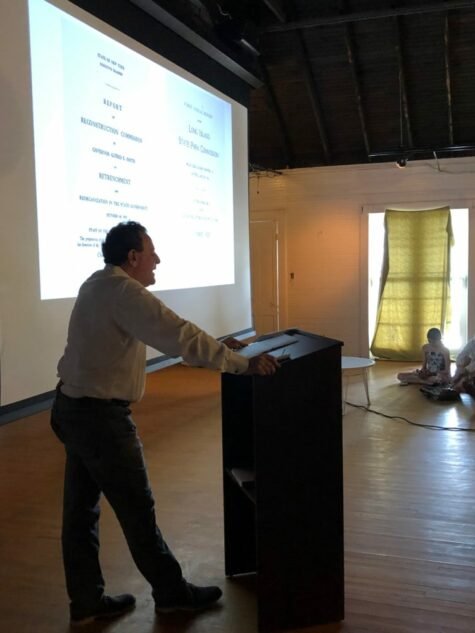
A standing-room-only crowd of more than 200 packed the casino in Point O’ Woods on the afternoon of June 8, for the annual Robert F. Sayre Memorial Lecture. Dunewood resident Jim Rosenthal presented a talk and slide presentation, sponsored by Point O’Woods Historical Society, titled “Robert Moses’ 40-Year Quest to Build a Highway through Fire Island.” Attendees were treated to a reception following the talk.
Rosenthal began by discussing the rise to power of Robert Moses, the first president of the Long Island State Park Commission. Moses’ first major public project was the design and construction of Jones Beach, which opened in 1929, and could accommodate 25,000 cars. Among numerous other projects, the ever-ambitious Moses immediately began to plan an oceanside highway to connect Jones Beach to Smith Point Beach 38 miles to the east — much of which would bisect Fire Island and its communities.
Initially, Rosenthal noted, some residents were keen to the idea. Coulter Young, president of the Point O’ Woods Association, quickly offered to sell his property to the state and suggested others do the same. However, a majority of residents resisted the plan and the changes it would bring.
The stock market crash of 1929 occurred just two months after the opening of Jones Beach and hampered some of Moses’ building projects, but he countered by telling Fire Islanders that the highway, dubbed Ocean Parkway, could increase land value by as much as 600 percent. The parkway was built east to Gilgo State Park by 1934, where it stalled.
Rosenthal continued by noting that Moses took advantage of the devastation caused by the Hurricane of 1938 in an effort to move forward with the highway project. Moses suggested using the highway as a protective barrier against the ocean, calling for 35 million cubic yards of sand to be pumped onto the beach and the creation of a 200-foot-wide boat channel through the bay.
Rosenthal presented a letter written to The New York Times in 1938, by resident Elmer Davis, who asserted, “This is no mere reaction to the hurricane … [Moses] would save Fire Island the way Hitler is saving the Sudeten lands.”
A facsimile was shown of a 1956 publication by the Department of the Interior, titled “Our Vanishing Shoreline,” which encouraged the preservation of natural beach habitats, and the Kennedy administration further championed environmental protection that contrasted with Moses’ plan to drastically alter Fire Island’s composition.
The Ash Wednesday nor’easter of 1962 prompted yet another push by Moses, but residents fought back harder than ever. Murray Barbash and Irving Like of Dunewood created the Citizens Committee for a Fire Island National Seashore and mounted a campaign to convince Congress to permanently protect the island from further development. Facing opposition from Governor Nelson Rockefeller and many constituents, Moses resigned from most of his state posts in 1963. The National Seashore was established in 1964 and the highway plan was finally put to rest.
The lecture closed with a statement made by Moses at the 1964 dedication of the causeway that would eventually bear his name: “The white heron nesting in numbers off the causeways and Ocean Parkway at Jones Beach in the shrubbery we planted are no more disturbed by passing cars than the lions in the game refuges in Tanganyika.”
A recording of the 1963 protest song “Slow Down Moses” by Julius Monk was played and copies of the lyrics were distributed. Born on Dec. 18, 1888, the 130th anniversary of the birth of Robert Moses renewed insterest in this controversail titan in New York history, as well as the organized resistance of Fire Island residents to stop him.
Rosenthal spent many summers with the residents who fought the highway plan, having first come to Dunewood in 1965. He is an award-winning magazine and newspaper journalist, a former producer for CBS and ABC, and a managing partner with the Mintz Group, an investigative services firm.
The Sayre lecture series is named for the late Dr. Robert F. Sayre, an English professor at the University of Iowa, who spent summers in Point O’ Woods beginning in 1934. The content of his first lecture for the Historical Society in 2012 was compiled into a book, and the lecture series has continued in his honor after his death in 2014.































